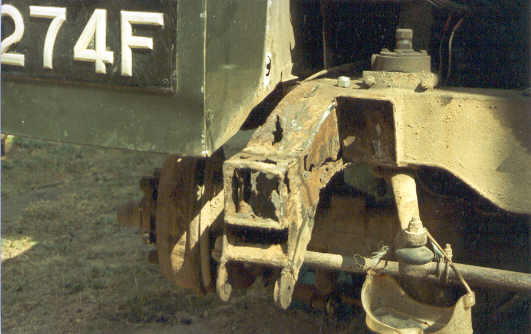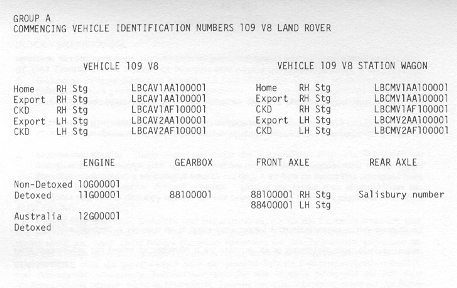The general construction of the Stage One V8 is the same as the rest of the Land Rover Series III range, so all I have done here is to cover the areas and potential problems unique to this vehicle.

V8 engine - illustration from owners handbook
Engine: The Rover V8 is basically tough and simple to work on, but it has a few well known weaknesses. Unless scrupulously maintained, it can suffer from camshaft wear, blown head gaskets, timing chain wear and sudden loss of oil pressure, typically from around 90,000 miles onwards. RPI Engineering of Norfolk has an excellent website which provides all the information you will need on V8 problems. Basically, look out for misfiring and spitting back through the carburettors (cam wear), and a lack of power (head gaskets). There are only two waterways between head and block (one at each end) so a head gasket failure does not usually lead to overheating or water loss. The gaskets usually fail on the inner side of the head, allowing exhaust gases to blow into the middle of the vee between the cylinder rows. Unfortunately this is where the camshaft lives, and the whole area becomes clogged up with black soot which contaminates the oil and accelerates camshaft wear. A compression test will indicate whether there are head gasket problems. Engine parts are cheap and readily available - around £350 will buy enough parts to sort out all the problems listed above.
Gearbox: The LT95 four-speed box was originally designed for military applications, so it is massively strong but a bit truck-like. The gearchange is slow and heavy, and expect a bit of gear noise. Check that the differential lock works (light should illuminate on dash when engaged), and make sure the transfer box works in both high and low ratios.
Axles: Both front and rear axles are unique to the Stage One. The rear axle is a Salisbury unit, the same as the four cylinder vehicles apart from a higher ratio (3.54 instead of 4.7). It is almost indestructible, unless allowed to run low on oil. The front axle uses a Range Rover differential, but driveshafts and steering swivels are unique to this model and likely to be very expensive to replace. The good news is that everything is heavy duty, but if the chrome balls are rusted, allowing all the oil in the steering swivels to leak out, this may destroy the CV joints in the driveshafts.
Propshafts: Both unique to this model. The rear prop is a standard design and easy to overhaul, but the front has a strange double joint at the gearbox end - two spider joints with a centralising device between them. Some have grease nipples for the centralising device, some don't, and if the centralising device runs dry, it quickly wears and leads to horrendous driveline vibration. It's a swine to replace, and quite expensive (about £80 for the centralising device and spider joints). So beware of any vibration, especially under load.
Radiator: Unique to this model, and frighteningly expensive to replace (£700 new). It will be cheaper to have the existing rad reconditioned, but if it is beyond repair, you will have a lot of trouble finding a good second hand replacement.
Chassis: From around 1977-1983, the quality of steel used by Land Rover was very variable, and all Stage Ones were made in this period. I bought one way back in 1990 which had already had the rear half chassis replaced due to corrosion, and the same year I saw another vehicle which had been scrapped at ten years old because the chassis was totally rotten. On the other hand, some vehicles seem to have survived very well. My last Stage One was twenty years old when I sold it and still had its original rear crossmember (although the chassis had been patched in a few places). Quite a few vehicles turn up for sale with replacement chassis, often galvanised steel - these are well worth paying the extra for, as a chassis replacement is a major job.

Typical chassis rot. This vehicle looked sound on initial inspection. It's an ex recovery vehicle, hence the coil 'helper' springs.

This is actually a Series 2A, but you can expect the same sort of problems on neglected Stage Ones. The worst of this was hidden by the front bumper - repair sections are available.

The owner of this Stage One started by cutting off the rear crossmember, then discovered there was no sound metal left to weld a new one onto. I rescued the vehicle, but it needs a new chassis for certain.
Fakes: People were putting V8 engines into Land Rovers at least ten years before the factory started doing it, and I have seen one such vehicle described as a Stage One. The only external distinguishing features are the flat front and V8 badging - both easy to duplicate. If the vehicle has part time four wheel drive (red and yellow gear knobs on the transmission tunnel) it is not a Stage One. The chassis number should have a 'V' in it, such as LBCAV1AA100001 - if it doesn't, the vehicle did not start life as a V8, and may not have the heavy duty transmission or uprated brakes of the genuine article. For more information on Land Rover vehicle and engine serial numbers, click here.

Living with a Stage One V8
The one thing all Stage One owners will comment on is the heavy fuel consumption. With a vehicle in good condition, you might see 20 mpg on a long run, but for day to day use 12-14 mpg is more likely. An LPG conversion would be fairly simple, as the engine is the same as the carburettor fed Range Rover (possibly the most popular vehicle for LPG conversions) and there is plenty of space to fit the gas tanks.
Other problems - the ride is very harsh, although not as bad as an 88 inch vehicle. You can fit parabolic leaf springs which will help greatly. Steering is non-assisted and very heavy, and the turning circle is huge. Avoid multi storey car parks unless you want to end up carrying your Land Rover down the stairs in pieces.
Like all Series III Land Rovers, the heater is pretty feeble, and rain gets into the cabin through the door seals and elsewhere. The vehicle is noisy to drive - sadly, the glorious sound of the V8 tends to be drowned out by transmission, tyre and wind noise. Soundproofing kits are available, and make a dramatic difference. Installing a stereo is a nightmare, especially in truck cab vehicles, as there is no sensible place to put the speakers.
The newest Stage Ones are now eighteen years old, and most have led a hard life (although station wagons tend to have been better looked after than the commercial versions). So you can expect things to go wrong - brakes, electrics and propshafts seem to give the most trouble. The V8 engine doesn't like getting wet, and unless the ignition system is carefully waterproofed, it is likely to die when driving through floods. The main reason is that the distributor sits right at the front of the engine, just behind the cooling fan. So if the water is deep enough to reach the bottom of the fan, the distributor gets drowned.
Insurance tends to cost much the same as for the four cylinder vehicles - I pay around £150 per year, third party fire and theft. Those parts which are shared with either four cylinder Land Rovers or Range Rovers are usually fairly cheap from specialists, but parts unique to the Stage One (axles, propshafts and front bodywork) can be expensive and hard to find.
But don't be put off - if you want a Land Rover for off roading, long journeys or towing heavy loads, the Stage One V8 rules. A really good example will set you back around £2,500 - £3,000. A project vehicle will be much cheaper - mine (a very original example, but needing engine work and new springs) was £1,150. The real problem is finding one - the vast majority went for export, and good straight vehicles, especially pick-ups, are hard to find in the UK. The Stage One V8 is much cheaper and easier to maintain than an early 110 at the same price (simpler suspension, no power steering and a stronger gearbox), and will certainly attract more attention.
Glencoyne Engineering - Land Rovers for sale